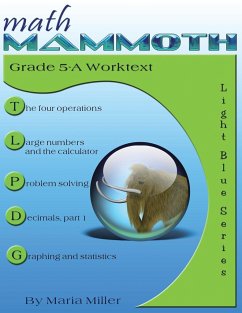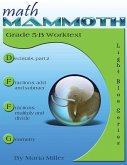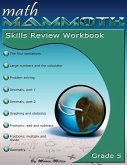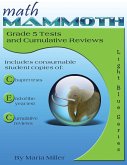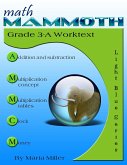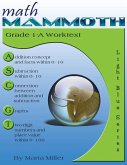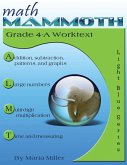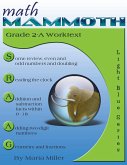Math Mammoth Grade 5-A Worktext is the student worktext for the first half of 5th grade mathematics studies. This is the older, 2020 edition. The newest edition is the 2023 edition. The book starts out with a study of whole numbers and their operations. Students review multi-digit-multiplication and learn long division with two-digit divisors. We also review divisibility and prime factorization from fourth grade. In the second chapter, the focus is on large numbers and using a calculator. This is the first time a calculator is introduced in Math Mammoth complete curriculum. I want students to learn to be critical in their use of the calculator and use it with good judgment. Every exercise where calculator use is allowed is marked with a little picture of a calculator. The third chapter is about equations and problem solving. We study simple equations with the help of a balance and bar models. The main goal is to get students used to the concept of an equation and what it means to solve an equation. Students also solve a fair amount of word problem with the help of the visual bar model. The fourth chapter is about decimals and some of the operations with decimals (the rest are studied in book 5-B). In fifth grade, students learn all the basic operations with decimals. In this chapter, we focus on place value with decimals, addition and subtraction of decimals, and multiplication and division of decimals by whole numbers. Multiplying decimals by decimals and dividing decimals by decimals is covered in chapter 6. In chapter 5 we study graphing in a coordinate grid, line and bar graphs, and average and mode. Today's world has become increasingly complex with lots of data presented in the media, so our children need a good grasp of statistical graphs to be able to make sense of all of that information. The rest of the 5th grade topics are covered in the 5-B student worktext. FeaturesMath Mammoth focuses on conceptual understanding. It explains the "WHY", so your children can understand the math, not just learn "HOW" to do it. Concepts are often explained with visual models, followed by exercises using those models. These visual models can take the place of manipulatives for many children; however, it is very easy to add corresponding manipulatives to the lessons if so desired. The curriculum is mastery-oriented. This means it concentrates fairly long on a topic, delving into its various aspects. This promotes conceptual understanding, as opposed to spiral curricula that often tend to jump from topic to topic too much. There is a strong emphasis on mental math and number sense. Very little teacher preparation is required. The curriculum has no separate teacher's manual nor is it scripted. The introduction to each chapter has some notes for the teacher concerning the material in the chapter. All the instruction is written directly to the student in the worktext, and there also exist accompanying videos where you can see Maria herself teach the material. After each chapter introduction, you will find a list of Internet links and resources (games, quizzes, animations) that can be used for fun, illustrations, and further practice.
Hinweis: Dieser Artikel kann nur an eine deutsche Lieferadresse ausgeliefert werden.
Hinweis: Dieser Artikel kann nur an eine deutsche Lieferadresse ausgeliefert werden.
